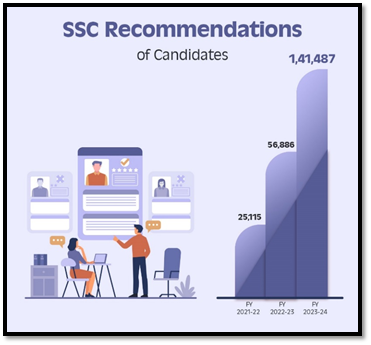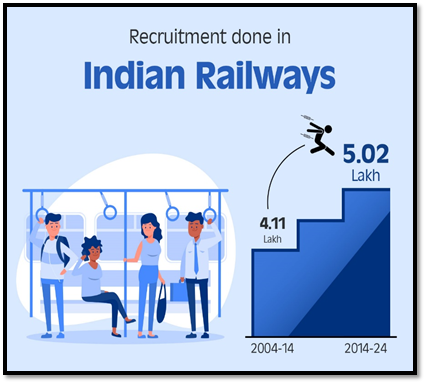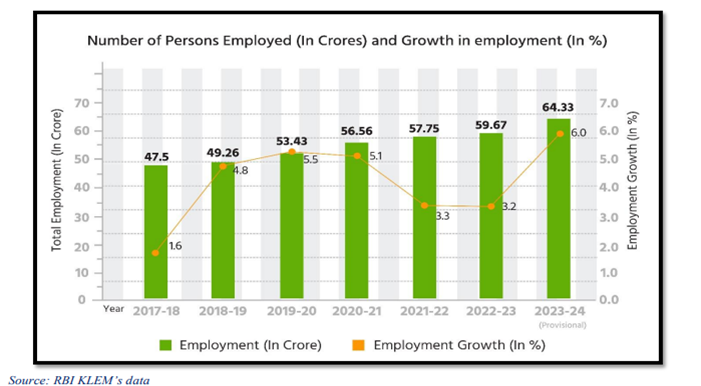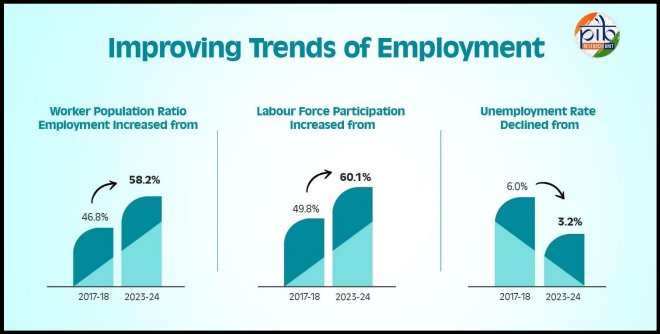Positive Momentum in Government Recruitment
India’s job market has seen significant growth in recent years, driven by the country’s youthful demographic—65% of the population is under 35, creating a large pool of talent to fuel economic growth. This rising demand for jobs is reflected in the increasing recruitment efforts by the government. In 2023-24, the Ministry of Personnel, Public Grievances, and Pensions reported a substantial rise in hiring for Group B and Group C posts, with 1,41,487 candidates recommended for various ministries and departments. This marks the highest recruitment in a decade, highlighting the government’s ongoing commitment to filling key positions and strengthening the public sector workforce.[2]
Overview of SSC Recruitment Trends
The Staff Selection Commission (SSC) plays a pivotal role in meeting these staffing needs, as it is the primary agency responsible for recruiting candidates for Group B and Group C posts across Union ministries and their affiliated offices.

In the Financial Year 2023-24, the Commission recommended 1,41,487 candidates for various ministries and departments. These numbers highlight the significant scale of the SSC’s recruitment efforts and its vital role in meeting the rising demand for government jobs across India.[3]
A significant portion of the selections was made for roles such as constables in the CAPF
Central Armed Police Forces), riflemen in Assam Rifles, and sepoys in the NCB (Narcotics Control Bureau), with 46,554 candidates filling these positions. These categories reflect the government’s focus on operational and law enforcement roles within Group C.[4]
Key Growth in UPSC Selections

In addition to SSC’s efforts, the Union Public Service Commission (UPSC) also contributed to recruitment by conducting 15 exams in 2022-2023. A total of 4,195 candidates were recommended for various posts. Out of the 1,697 reserved posts for SC, ST, OBC, and EWS candidates, the Commission recommended 1,409 candidates, filling 83.1% of the reserved positions. highlighting the government’s focus on diversity and equitable representation.[5]
Upward Trend in Recruitment in Indian Railways
Indian Railways continuously fills vacancies to meet operational needs, technological advancements, and growth. Recruitment is primarily done through indents with agencies, based on operational and technological requirements.

Post-COVID, two major exams were conducted for over 2.37 crore candidates:
- CBT (Computer Based Test) for 1.26 crore candidates in 7 phases (Dec 2020 – Jul 2021) across 211 cities.
- CBT for 1.1 crore candidates in 5 phases (Aug 2022 – Oct 2022) across 191 cities.
These efforts led to the recruitment of 1,30,581 candidates.
The Ministry of Railways has introduced a system of publishing an annual calendar this year for recruitment to various categories of Group ‘C’ posts. Accordingly, four Centralized Employment Notifications (CENs) for 32,603 vacancies have been notified during January to March 2024 for filling up of posts of Assistant Loco Pilots, Technicians, Sub-Inspectors & Constables in Railway Protection Force (RPF).[6]
Private Sector Employment Trends Across Indian Economy
The KLEMS database, recently released by the Reserve Bank of India (RBI), provides a comprehensive snapshot of employment trends across the Indian economy. In the latest update to the KLEMS database, provisional estimates for the year 2023-24 reveal significant growth in employment:
- Total Employment: Employment in India is projected to reach 64.33 crore in 2023-24, up from 47.5 crore in 2017-18.
- Employment Growth: The total increase in employment between 2017-18 and 2023-24 stands at approximately 16.83 crore, translating to an average annual increase of 2.8 crore jobs per year.
- 2023-24 Growth: For the year 2023-24, the RBI estimates an additional 4.67 crore jobs compared to the previous year, 2022-23, reflecting a robust pace of employment creation.

These figures highlight a positive trend in job creation in India, showcasing substantial growth in employment across key sectors over the past few years. Total estimated employment in the country has increased to 59.67 crores during 2022-23 as compared to 47.50 crores during 2017-18.
The Periodic Labour Force Survey (PLFS), conducted by the Ministry of Statistics and Programme Implementation (MoSPI) since 2017-18, serves as the official data source for employment and unemployment indicators in India. This survey provides key insights into employment trends, including crucial metrics such as the Labour Force Participation Rate (LFPR), Worker Population Ratio (WPR), and Unemployment Rate (UR) for individuals aged 15 years and above. According to the report,
- Worker Population Ratio (WPR), which measures employment, has risen from 46.8% in 2017-18 to 58.2% in 2023-24.
- Labour Force Participation Rate (LFPR) has increased from 49.8% in 2017-18 to 60.1% in 2023-24.
- Unemployment Rate has decreased from 6.0% in 2017-18 to a low of 3.2% in 2023-24.

Conclusion
The growth in job creation and the shift towards a more formal workforce in India highlight the government’s focus on boosting public and private employment. These efforts are helping to build a dynamic and inclusive workforce while making the recruitment process more transparent. As a result, the public sector job market is becoming more efficient and accessible. With continued emphasis on job creation, India’s employment outlook looks positive, offering more opportunities for the future.
Public participation is necessary for good governance
A two-day regional conference on “Good Governance” started today in Nava Raipu…


















